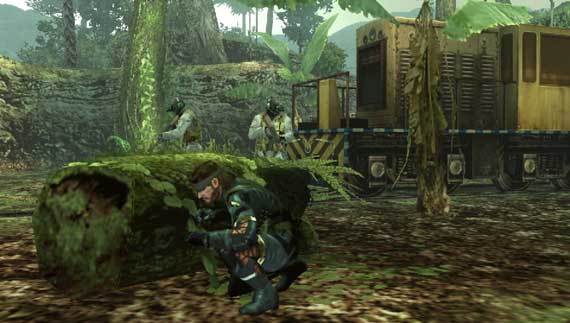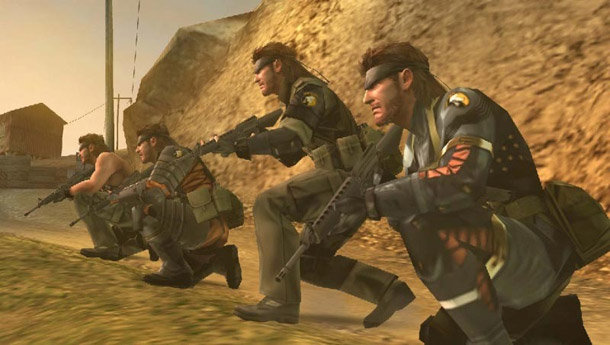The Metal Gear series has had a bit of a shaky run on the PSP, starting with the bizarre Metal Gear Acid games and continuing with Portable Ops, a game that provides a MGS-lite experience that is held back by a very tedious soldier-capturing system.
Now that series creator Hideo Kojima has decided to take the reins of the newest PSP entry, Metal Gear Solid: Peace Walker, we have received a game that is very much a MGS game. It’s also a game that is perfect for the PSP platform, utilizing every ounce of its strengths and delivering an experience that can easily be experienced on the go or in a long, involved session
Peace Walker is a game that takes a lot of its inspiration from another extremely popular PSP franchise, Monster Hunter. Everything from the structure to the CO-OPS feature to the weapon and item creation is infused with a little Monster Hunter spirit, but with an MGS spin. The game’s missions are separated into two categories: Main Ops and Extra Ops. Main Ops are the game’s story missions, which see Big Boss building his own army and trying to stop a new bi-pedal nuclear weapon named Peace Walker. These missions feel very much like a big-budget game and the developers never dumb down the mission objectives or level design as so many other portable games do. They missions are intelligently designed for a portable platform and still make you feel like you are playing something much more.

Extra Ops are even shorter, side missions that you can play to gain more resources to help you in the main story. These missions are all built for the CO-OPS feature, whereas only some of the Main Ops allow more than one player. Extra Ops will have you rescuing prisoners, capturing new soldiers, or even retrieving R&D docs to build new weapons and items. Some have you facing bosses again, giving you another chance to gain precious items, which I won’t spoil. They unlock as you progress in the story and there are quite a few of them (I had missions numbered in the 100s after I beat the game), so you’ll be spending a lot of time here after you complete the story if you want.
CO-OPS, or Cooperative Operations, is the main co-op system in place here. You can play almost every mission in the game with 2-4 players. Each player takes control of a different Snake and can bring their own weapons and items with them when they join a game. Players can then Coop In with another player by entering their radius and can share items and weapons and gain an extended health bar. If all 4 players do this, they gain a substantial boost. There are also numerous items built for multiple players, including some cheeky items like a Tank Box that one player can shoot while the other pilots. Players can operate on different parts of the map, completing objectives if needed. I had a lot of fun playing this way with friends and it opened new strategic possibilities during missions. That said, there are a few missteps in the design of CO-OPS that hold this mode back from being a great innovation. One, you can only play AdHoc, meaning no online play. This is a very odd omission as both Portable Ops and Portable Ops Plus had online play. Second, some of the later story missions and Extra Ops missions almost require CO-OPS play if you hope to succeed. The difficulty ramps up dramatically towards the end of the game and just like the complaint I had with Monster Hunter Tri, you’ll need more players if you want to make it easier. Again, this is odd in a game from the MGS franchise — one that has focused on very solo affairs in the past. Some missions will require more players and others are perfectly balanced for solo play.

When you’re not on missions, though, you’ll be building your very own army as in Portable Ops. Every soldier you encounter has a letter grade and is proficient in Combat, R&D, Medical, Food, or Intel. As you capture soldiers you can assign them to one of those teams. The more soldiers you have on any specific team, the higher its level. As the team level grows, it allows you to research new weapons and items. It also adds to your GMP, which is the currency you use to make the equipment. Basically, the more proficient soldiers you have the better items you can make. You can also send these guys out on Outer Ops where they can level up, return with more items, and gain more GMP. Don’t worry about micromanagement, though. The game offers to assign soldiers for you and track your development so you can focus on sneaking and shooting.
The game looks and plays wonderfully on the PSP. The retooled MGS4 control scheme that is default here works very well on the PSP and the game also offers a Portable Ops scheme or even one based on Monster Hunter if you choose. The graphics push the PSP harder than any other game I’ve played on the system and there are some later missions that boast some beautiful effects and explosions. There’s rarely any slowdown during these sequences. The motion comic cutscenes from Portable Ops also return, beautifully drawn by artist Ashley Wood, and they are now interactive. Certain cutscenes will require a timed button press or allow you to zoom in and look for hidden details. Couple this with some enjoyable and astounding boss fights and Peace Walker is the game to beat on the PSP.
As far as PSP games go, Peace Walker is a shining example of what can be done on the platform. Aside from a frustratingly difficult endgame and a missed opportunity with an online feature, Peace Walker is an addictive and fun experience that takes portable games to new heights.


















